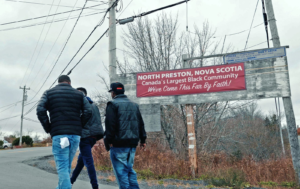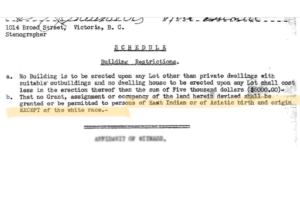What is racial segregation? It’s an important term to understand and is defined as the separation of people or groups of people, based on race in everyday life. In fact, Canada has a history full of examples of Black people being segregated, excluded from, or denied equal access to opportunities and services such as education, employment, housing, transportation, health care and commercial establishments. This segregation was historically enforced through laws, court decisions and social norms in Canada. The areas in this article of segregation that will be explained are those of housing and employment.
Housing

Historically, land grants and residential housing was given to residents of the colonies in what is known today asCanada. However, they were often restricted based on race. For instance, some Black Loyalists in Nova Scotia and Ontario did not receive any of the promised land grants and those who did, were given smaller allotments on land of poor quality in places physically segregated from white settlers. Examples such as the Black communities of North Preston in Nova Scotia and Elm Hill in New Brunswick exist.
Decades later, there were still important acts of segregation and discrimination in practice in Canada. There are many examples of land titles using covenant clauses to prevent the sale or rental of property to Black people and other racialized groups. For example, a clause in Vancouver real estate deeds going back to at least 1928 and included as late as 1965 stated, “That the Grantee or his heirs, administrators, executor, successors or assigns will not sell to, agree to sell to, rent to, lease to, or permit or allow to occupy, the said lands and premise, or any part thereof, any person of  Chinese, Japanese or other Asiatic race or to any Indian or Negro.” In the 1920s, city officials in Calgary, Alberta wrote restrictive contract clauses to prevent Black residents from purchasing homes outside of the boundaries of the railway yards. In Sarnia, Ontario, a 1946 property deed for a Lake Huron community of approximately 100 cottage lots specified that property could only be owned by whites of a particular background and could not be “transferred by sale, inheritance, gift, or otherwise, nor rented, licensed to or occupied by any person wholly or partly of negrio, Asiatic, coloured or Semetic blood…”
Chinese, Japanese or other Asiatic race or to any Indian or Negro.” In the 1920s, city officials in Calgary, Alberta wrote restrictive contract clauses to prevent Black residents from purchasing homes outside of the boundaries of the railway yards. In Sarnia, Ontario, a 1946 property deed for a Lake Huron community of approximately 100 cottage lots specified that property could only be owned by whites of a particular background and could not be “transferred by sale, inheritance, gift, or otherwise, nor rented, licensed to or occupied by any person wholly or partly of negrio, Asiatic, coloured or Semetic blood…”
Instances and the practice of Blacks systematically being turned away because of their race when searching for rental accommodations were very common. This greatly limited their options of places to live. Over time, this systemic discrimination resulted in the heavy concentration of Black residents in some neighbourhoods in major urban centres in Canada such as Little Burgundy in Montreal.
Employment and Trade Unions
Not only has racial segregation been present in education and in housing, but it also affected many areas of employment in Canada. Black women and men historically had to work in the service sector as barbers, waiters, labourers, janitors, domestic servants, sleeping car porters. (Here is a link to a youtube video showing Black sleeping car porter’s living conditions:https://youtu.be/LkYJKL5yd0U). Their jobs were relegated to this sector regardless of their education or qualifications. Nor government agencies nor white business owners hire or promote Black people traditionally. Workers began forming trade unions to improve working conditions and quality of life for employees near the end of the 19th century, however Black workers were denied membership to these unions systematically. In addition, worker’s protection was reserved exclusively for whites.
Sources:Canadian Encyclopedia: https://www.thecanadianencyclopedia.ca/en/article/racial-segregation-of-black-people-in-canada

























